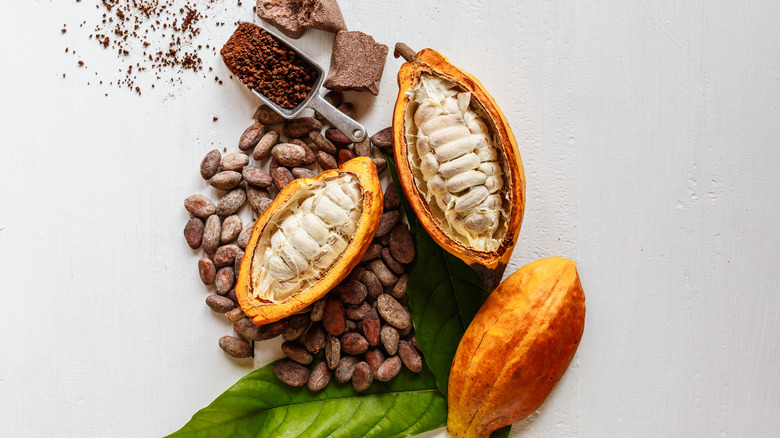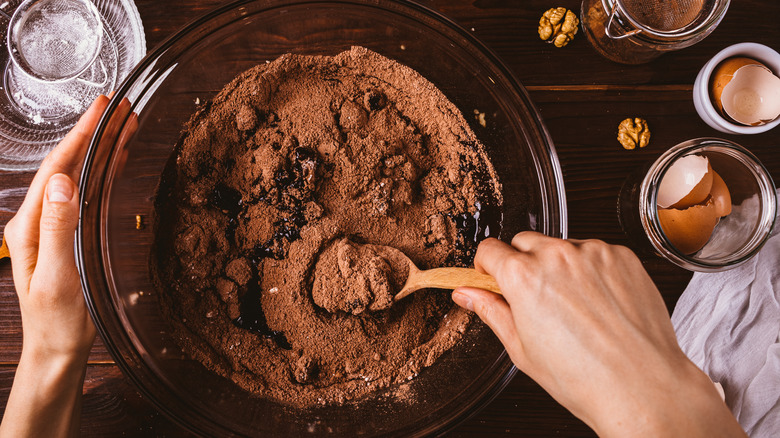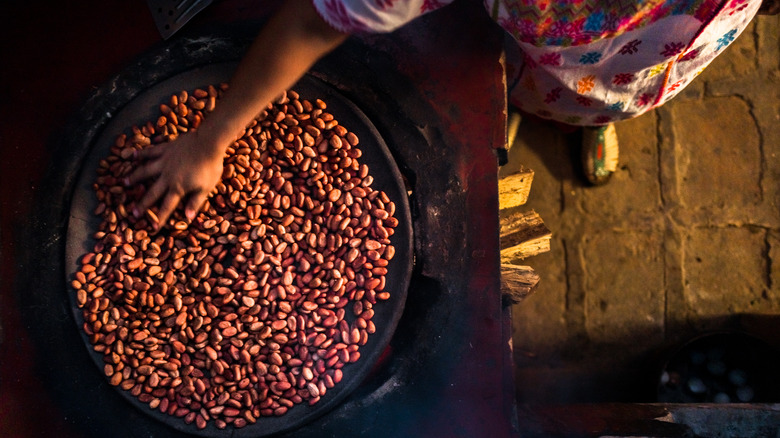Dutch Process Cocoa Powder Vs. Natural: What's The Difference?
From a humble seed pod to the world's most craved candy, chocolate has come a long way. The process starts by harvesting ripe, yellowish-orange cacao pods, which are hand-picked from cocoa trees growing in the wet, lowland tropics of Central and South America, West Africa, or Southeast Asia. These pods each contain around 50 seeds (also called beans) that are removed from the husk and processed into usable cocoa powder. The beans are then air-fermented in covered trays for about a week, during which time the seeds begin to change color from a fleshy, milky white to a light coffee brown. After fermenting, the cocoa beans are dried in open trays for another week, resulting in darker seeds that weigh half as much as when they were harvested (via The World Atlas of Chocolate).
At this point, the beans are packaged and distributed to chocolate manufacturers, who roast, crush, and blend the cocoa nibs from the heart of the seeds. How It's Made shows how the nibs are ground to release the cocoa butter, creating a paste called cocoa liquor because of its smooth liquid texture. To make cocoa powder for baking, the cocoa butter is pressed out of the cocoa liquor, leaving a dried, ground-up powder. This is the process for natural cocoa powder, however, this is not the process for all cocoa powder, as Dutch-processed cocoa powder has one important step in the process that makes a world of difference.
Pass the Dutch process
You may have seen Dutch-processed cocoa powder in a recipe or hanging out in the baking aisle of the grocery store and assumed it was indistinguishable from natural cocoa. However, it's alkalized, giving it a different pH. In Dutch processing, the beans are soaked in an alkaline solution of potassium carbonate or sodium bicarbonate (baking soda) before being fermented and dried. Because cocoa beans are inherently acidic, the alkaline solution helps to neutralize some of the acidity, resulting in a darker bean, with milder, less bitter notes that are preferred by some bakers and confectioners (via Martha Stewart).
In addition to changing flavors, alkalized cocoa has an effect on the chemistry of the dish in which it's used. According to King Arthur Baking, because naturally processed cocoa retains its natural acidity, recipes incorporate baking soda to enhance leavening and neutralize pH. Like a science fair volcano, the acidity of the cocoa oxidizes creating air bubbles, resulting in fluffier baked goods. Dutch-processed cocoa, on the other hand, doesn't have that acidity, so recipes that incorporate it usually prefer baking powder to soda. This results in darker, denser, and cakier desserts that have a richer, malty flavor, contrary to natural cocoa which results in lighter-colored, slightly bittersweet products. When using these cocoa powders interchangeably, it's important to consider the other acidic or basic elements that may be going into the mix (like citrus juice, vinegar, etc.) and to adjust ingredients like baking soda accordingly.
Loco for powdered cocoa
Though all cocoa powders can be categorized as either natural or Dutch-processed, within these families there are even more varieties. King Arthur Baking sells a handful of different cocoa powders distinguished by their purity and levels of Dutch processing; the darkest and most heavily Dutched being black cocoa, which boasts an intense richness of dark chocolate. Additionally, the company sells two classically Dutched cocoa powders; the full-flavored Burgundy cocoa powder and the more traditional, cocoa fat-rich Bensdorp cocoa powder. If you're looking for an all-purpose powder, blends are also an option, like their double dark cocoa blend or triple cocoa blend that features black, natural, and Dutched cocoa powders, perfect for any recipe that calls for cocoa. There's even a ruby cocoa drink powder from Dutch brand Van Houten, per Barry Callebaut.
As the world's love of chocolate grows, more and more avenues of innovation are being explored while some of the traditional preferences still hold strong. Cocoa powder is still a household necessity, but with ever-increasing options on the market, we may see an increase in blends that attempt to capture the best of both processes: the organic, nuanced flavors and bite of naturally processed cacao, as well as the smooth, subtle richness of Dutch-processed cocoa.


